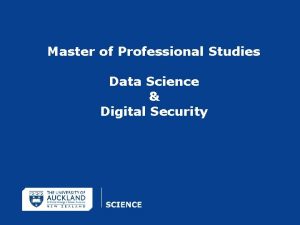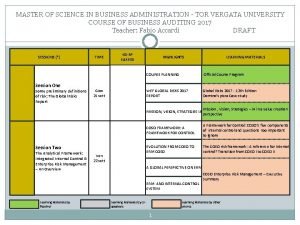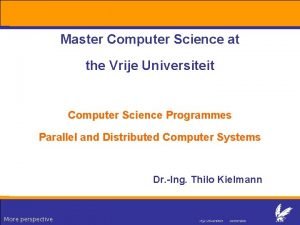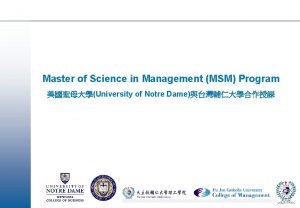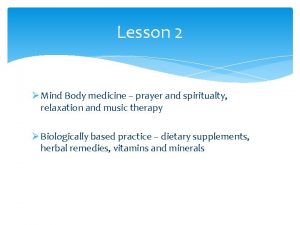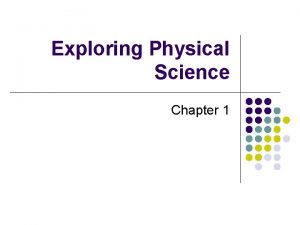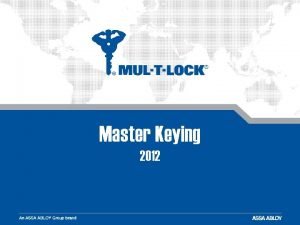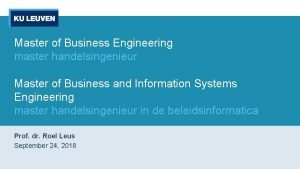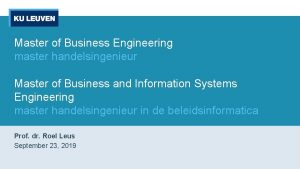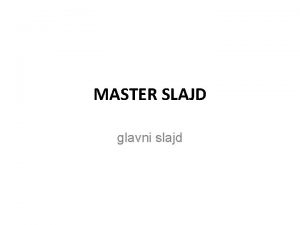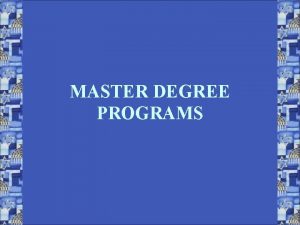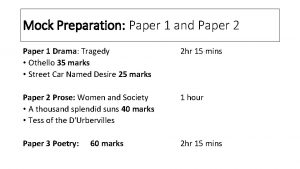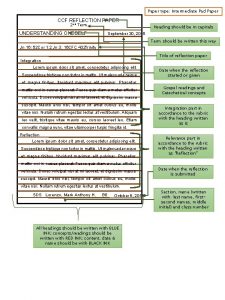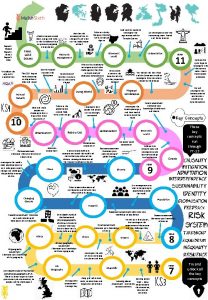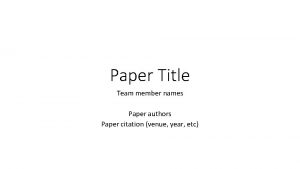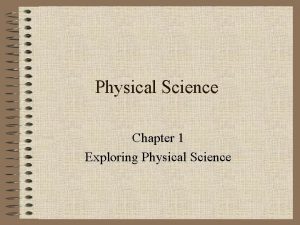MASTER OF SCIENCE EXPLORING SPIRITUALTY Paper II Sanskar























- Slides: 23

MASTER OF SCIENCE EXPLORING SPIRITUALTY Paper –II

Sanskar Re-modeling Unit I

How is a sanskar formed? Repeating a thought or action becomes spontaneous – which is called as sanskar or habit Why do we need to re-model our sanskar? Unrighteous actions due to body consciousness has led to negative sanskars, so the need to remodel them.

The hope lies in a funny and interesting characteristic of the sub conscious

The subconscious mind cannot differentiate between an action performed or an action performed on the mind’s screen For sanskar remodeling Do positive visualisation & positive emotions Give auto suggestions

Between willpower and visualisation which is powerful?

Objectives After reading this unit, you should be able to: Describe the importance of Sanskar Re-modeling Examine theory of self-transformation Explain about different approaches in sanskar remodeling Understand various methodologies used in sanskar re -modeling Enumerate different training methods available in sanskar re-modeling

Theory of Self -Transformation

Sub conscious programming through controlled, pre-determined positive visualisation in physically mentally relaxed state

External Triggers Seeing, taste, sensing and smelling etc Internal Triggers Emotions like frustration, boredom, loneliness, mild depression, anger, hatred, revengefulness etc…

Methods to diversify negative stimulus Technique 1: Dissociation (detachment, trustee) Technique 2: Association Conditioning is a repeated practice of emerging a stage to the extent that it becomes your second nature. If it is a root cause, it has to be directly attacked, but if it is a derivative, then the root cause of such derived negative sanskar has to be identified and worked on.

Pattern and trend of emergence of –ve sanskar This analysis includes How often it emerges Intensity weather it is very much uniformly strong or it varies from time to time Specific time, situation, environment or persons that trigger the negative sankars Some specific thoughts, imagery, people, etc. who might have acted against the negative triggers and dampened its effect in the past

Three Methods for remodeling Being totally involved in Godly Service R & D Activities Accept Responsibility

Law of dominant effect – Emile Coue The most emotionally powerful suggestion dominates the mind and intellect at a particular point of time. This means that we have to visualize all knowledgeful suggestion in a fashion that will be emotionally strong and enjoyable and hence win over any other negative or waste thoughts

Method for re-modeling v. Relaxation techniques v. Conditioning techniques v. Logos

Relaxation Techniques q. Progressive Relaxation q. Instantaneous Relaxation – intentional tiring of the muscles of the upper eye lids q. Restricted awareness Relaxation (listening to silence)

Conditioning techniques Suggestions while Breathing – as I inhale, my level of enthusiasm is increasing and as I exhale, all feelings of frustration are moving out of me Suggestions while walking – pumping in self confidence Suggestions while climbing Counting numbers

Suggestions for remodeling Hetero suggestions: Guiding to think by external commentary or by reading or seeing some symbols/ gestures Auto Suggestions: Self-thoughts Classification 1. Waking suggestions: Karamayogic Sankalp 2. Sleep Suggestions: Rajyogic Sankalp 3. Post Meditative Suggestions: to bring desired change permanently in life

What is suggestibility? The capability of a person’s subconscious to accept a suggestion, i. e. to bring it into an embodiment is called suggestibility.

Laws of Suggestions – Emile Coue, a French Pharmacist Law of Concentrated attention – when a person concentrates his attention on an idea, the idea tend to realize itself The Law of Reverse Effort – When a person thinks he cannot do something, and then tries, the more he tries to do it, the less able he is in doing it The Law of Dominant Affect – Suggestions linked to an emotion will surmount any other suggestion in the mind at that point

Methods of using suggestions 1) Psycho-feedback method – used to stop obsessional habits, bad habits etc 2) Visualization method – strongest tool in which the desired behavior is picturised mentally 3) Desensitization method – used specially for removing phobias, shocks, fear of failure, obsessional desire 4) Fractionating method- it is a means to deepen the stage of yoga and not direct re-modeling

Following a Training Programme Rational Emotive Therapy It emphasises the importance of a person’s thoughts ideas, and perceptions in determining and influencing behaviour. It is based on the assumption that significant emotions and actions stem from the belief a person consciously or unconsciuosly hold

Thank You Omshanti
 Seemantonayan sanskar
Seemantonayan sanskar Favorite subject science
Favorite subject science Exploring physical science
Exploring physical science Mrp best practices
Mrp best practices Paper 2 aice general paper
Paper 2 aice general paper Aice general paper 1 example essay
Aice general paper 1 example essay Master of professional studies in data science
Master of professional studies in data science Tor vergata business administration
Tor vergata business administration Vu computer science
Vu computer science Notre dame msm
Notre dame msm Abstract science fair
Abstract science fair Airplane science project
Airplane science project Ocr a level computer science paper 1
Ocr a level computer science paper 1 Gcse computer science paper 2
Gcse computer science paper 2 Natural vs social science
Natural vs social science Brances of science
Brances of science Natural science vs physical science
Natural science vs physical science Applied science vs pure science
Applied science vs pure science Rapid change
Rapid change Science fusion online
Science fusion online Rule of 70 population growth
Rule of 70 population growth Windcube lidar
Windcube lidar Hard and soft science
Hard and soft science Why did europeans begin exploring?
Why did europeans begin exploring?






